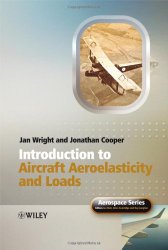Engineering Bookshelf
- Aerospace
- Biological
- Civil
- Chemical
- Environmental
- Electrical
- Materials
- Mechanical
- Petroleum
- Geoengineering
- Software

Introduction to Aircraft Aeroelasticity and Loads
by Jan Robert Wright, Jonathan Edward CooperPublisher: Wiley
ISBN: 0470858400
Check price @ amazon.com , amazon.ca , amazon.co.uk
Book Description
Aircraft performance is influenced significantly both by aeroelastic phenomena, arising from the interaction of elastic, inertial and aerodynamic forces, and by load variations resulting from flight and ground manoeuvres and gust / turbulence encounters. There is a strong link between aeroelasticity and loads, and these topics have become increasingly integrated in recent years.
Introduction to Aircraft Aeroelasticity and Loads introduces the reader to the main principles involved in a wide range of aeroelasticity and loads topics. Divided into three sections, the book begins by reviewing the underlying disciplines of vibrations, aerodynamics, loads and control. It goes on to describe simplified models to illustrate aeroelastic behaviour and aircraft response before introducing more advanced methodologies. Finally, it explains how industrial certification requirements for aeroelasticity and loads may be met and relates these to the earlier theoretical approaches used.
- Presents fundamentals of structural dynamics, aerodynamics, static and dynamic aeroelasticity, response and load calculations and testing techniques.
- Covers performance issues related to aeroelasticity such as flutter, control effectiveness, divergence and redistribution of lift.
- Includes up-to-date experimental methods and analysis.
- Accompanied by a website with MatLAB and SIMULINK programs that relate to the models used.
Introduction to Aircraft Aeroelasticity and Loads enables the reader to understand the aeroelastic and loads principles and procedures employed in a modern aircraft design office. It will appeal to final year undergraduate and masters students as well as engineers who are new to the aerospace industry.
Book Reviews
"This book is a welcome addition to the aeroelastician's armoury, as it brings the subject matter completely up-to-date, additionally adding a valuable and realistic industrial perspective." - (Aeronautical Journal, December 2008)
Customer Reviews
By Keiichi Ito
Aeroelasticity is a tough subject to start off. However, this book will pave your way quite substantially. Once you have gone through your first Flight Dynamics course (and by this time you most likely have taken the Vibration course too), you are ready to read this book. Totally self contained, the book is a smooth transition from rigid body representation of the aircraft to the elastic one. It covers not only the static and dynamic flutter, but also responses to gusts, atmospheric turbulence, landing, and rolling on ground.
Imagine your linear flight dynamic model taking into account the elastic degree of freedom along with unsteady aerodynamics. This is a very realistic and natural extension from the rigid body model but somehow I have hardly seen Flight Dynamics text books doing that, except Bernard Etkin's book very briefly touching on the topic. The current book fills this gap well at a level accessible to third or fourth year undergraduate student in Aerospace Engineering.